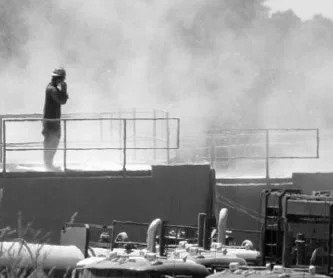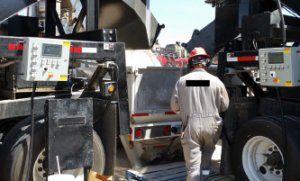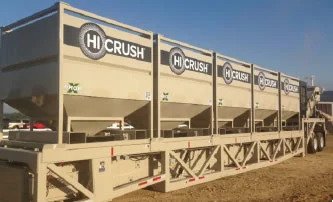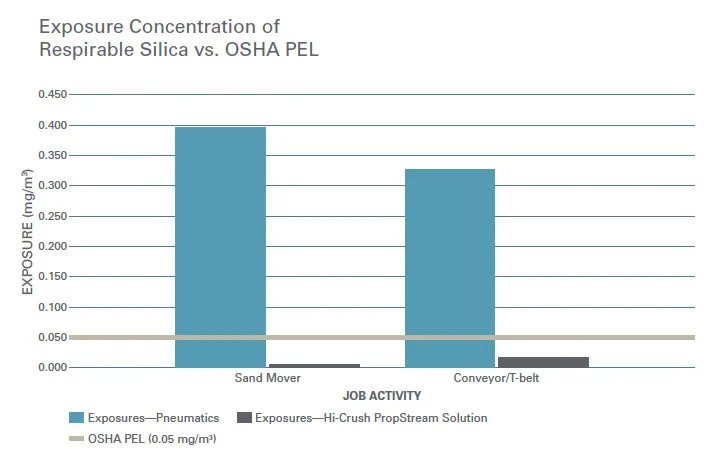MINIMIZING GENERATION OF, AND EMPLOYEE EXPOSURE TO, DUST AND SILICA DURING HYDRAULIC FRACTURING FOR WELL COMPLETION UTILIZING SAND
Categories: White Paper
Authored by: Jeffery A. Johnson, P.E., Director, Environmental Compliance
Date: May 2019
Introduction
Conventional hydraulic fracturing methods utilizing pneumatic-type material handling equipment generate a large amount of silica-containing dust. The immense amount of fugitive dust surrounding operations during this type of material handling may cause respiratory protection concerns for employees, fugitive dust complaints, decrease in visibility, and decrease in overall efficiency of operations. Regulatory agencies have focused on these issues and compliance with employee safety and environmental matters are a challenge. Technology does exist to deal with these issues, providing solutions to mitigating dust generation, minimizing employee exposures, while increasing operational efficiencies.
Background/Problems

Hydraulic fracturing utilizes a large quantity of sand (among other materials and chemicals). Delivering and handling the sand on site can lead to generation of fugitive dust and respirable crystalline silica. Equipment relying on pneumatic handling of the sand creates the highest concentrations of dust and silica. Data1 exists demonstrating employee exposures to dust and silica above the current, and future, Permissible Exposure Limit (PEL).
Environmental regulations exist for mitigation of dust (fugitive particulate); most state agencies require best management practices to minimize dust. Furthermore, more recently, the Occupational Safety and Health Administration (OSHA) published a rule on Silica2, setting a more stringent standard for employee exposure (25 μg/m3 Action Level, and 50 μg/m3 PEL), and requirements3 for implementing controls (including engineering controls for hydraulic fracturing by June 23, 2021).
Continuing to rely on pneumatic type operations for material handling may no longer be an option. New work practice and engineering controls are likely necessary to reduce the dust and silica generated to safe and compliant levels. Implementation of controls (under Federal OSHA standards) will be required, and providers and operators may struggle with the increased cost and efficiencies potentially lost, by implementing such controls.
Download And Read Later
Solution

Hi-Crush’s PropStream® integrated delivery solution has a delivery and material handling system, PropBeast™ (see photos at right), which significantly reduces dust generation, decreases employee exposure to dust and respirable crystalline silica, and can be operated in a manner which increases operational control and efficiency. The system is a self-contained solution which delivers sand all the way to the blender hopper with only a minimal release of dust as sand enters the hopper.4 Use of pneumatics for material handling and transfer is completely eliminated, as sand is contained in transportable containers, gravity fed onto an enclosed conveyor, and conveyed into the hopper.

Dust generation and the resulting employee exposures to dust and silica is significantly reduced; exposures have been shown5 to not only be below the existing and new PEL, but also below the lower Action Level,6 for operators of the PropBeast conveyors. The PropStream system can satisfy the engineering controls requirements under the OSHA silica rule, and significantly reduce the number of employees that may need additional reduction to exposure by utilizing respiratory protection.

Products/Services
Hi-Crush formed, with other partners, Proppant Express Investments, LLC (“PropX”), which was established to develop critical last-mile logistics equipment for the proppant industry. PropX is responsible for manufacturing the containers and the PropBeast conveyor systems used in Hi-Crush’s PropStream integrated delivery solution, designed to allow for safe and cost-efficient transportation of proppant from in-basin terminals to the wellsite while minimizing fugitive dust. PropStream involves loading frac sand at Hi-Crush in-basin terminals into the PropX containers before being transported by truck. The containers utilize readily available intermodal container chassis or standard flatbeds for transportation, resulting in significant savings in up-front costs versus widely-used pneumatic equipment. The containers also allow for increased transportation efficiency and a significant reduction in supply chain related congestion at wellsites, lowering the number of trucks required per job and significantly reducing or eliminating demurrage costs.
At the wellsite, the PropBeast conveyor system is comprised of two conveyor units that significantly reduce noise and dust emissions at the wellsite due to its fully enclosed environment. By reducing particulate matter emissions from sand operations at the wellsite by more than 90%, and achieving an overall reduction of operator’s respirable silica exposures by more than 96%, versus the widely-used pneumatic alternative, the PropStream solution is designed to provide a viable solution to meet the new OSHA respirable crystalline silica standards set to become effective in 2018, as well as the engineering control obligations set to become effective in 2021.
Conclusion
A technology-based, cost-effective, increased efficiency solution exists for minimizing the generation of, and employee exposure to, dust and silica during hydraulic fracturing; allowing for the achievement of environmental and safety regulatory compliance with Federal (OSHA) and State standards. The PropStream system, utilizing PropX containers and PropBeast conveyors, has scientifically proven reliability for mitigating dust and minimizing employee exposures to dust and silica, meeting those obligations.7 The Hi-Crush Silica Sand Safety Data Sheet (SDS) is available on our website at Customer Resources—Data Sheets. Additional resources are available, upon request, including: a one-page OSHA silica rule summary; the cited NIOSH exposure study journal article; and, a Hi-Crush PropStream brochure.
- Eric J. Esswein, Michael Breitenstein, John Snawder, Max Kiefer & W. Karl Sieber (2013) Occupational Exposures to Respirable Crystalline Silica During Hydraulic Fracturing, Journal of Occupational and Environmental Hygiene, 10:7, 347-356, DOI: 10.1080/15459624.2013.788352.
- OSHA Silica rule for general industry: §1910.1053, effective June 23, 2016.
- Multiple, and differing, requirements under the standard, §1910.1053, apply when exposures are above the action level but below the PEL, or when exposures are above the PEL.
- The only location for potential release of minimal dust to the workplace atmosphere is at the point at which the sand leaves the conveyor as it is fed into the hopper which subsequently feeds the blender.
- Operators have been sampled by Safety Department representatives, in accordance with proper procedures (OSHA standards), and resulting exposures analyzed by an appropriate accredited laboratory. Results from additional sampling may vary from those referenced herein dependent upon environmental conditions and other factors. Represented data may be made available upon request.
- The OSHA Silica standard, section §1910.1053, does not apply where objective data demonstrates exposures will remain below the defined action level under any foreseeable conditions [§1910.1053(a)(2)]; no further action is required for testing or for implementation of preventative or protective measure for the workforce. However, further actions may be required whenever a change in the process or work practices occurs [§1910.1053(d)(4)].
- The OSHA silica rule contains many obligations beyond the permissible exposure limit (PEL). Operators must be aware of those other obligations that must be satisfied, including but not limited to: exposure assessments/routine exposure sampling; written exposure control plan; respiratory protection and a respiratory protection program, where applicable; housekeeping; medical surveillance; hazard communication; and recordkeeping. While the PropStream system and PropBeast conveyors provide compliance with the PEL for those operating the equipment, and anticipated for most other employees on site (pneumatic operations would not), operators are still required to meet all other obligations. However, utilization of PropBeast provides a compliant solution to meeting the engineering and work practice controls requirements for sand handling activities. Supplemental respiratory protection may be necessary for other onsite employees, and operators must be aware of this and conduct necessary exposure assessments to make that determination.
